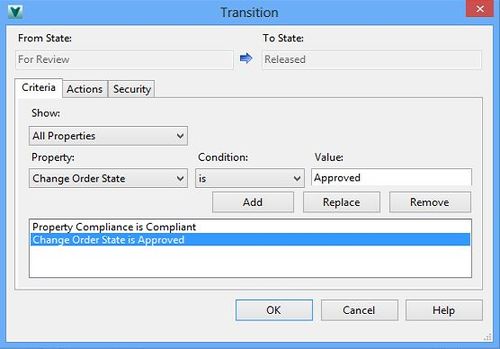We have spent a fair bit of time now learning how to control file and item release process through Vault ECO 's, releasing items when the ECO is done, making sure no changes can be made to files and items unless they are associated with an ECO and ensuring that the ECO cannot be moved to review unless its records are in the correct state, but we still have one small gap here, ensuring that record lifecycle state changes cannot be made unless your ECO is at the correct phase.
An excellent example of this is releasing files and items. While we are able to change the states of items after approving, how can we be sure that files and items are not released before approval?
Here we can rely on lifecycle transition rules, setting the correct Change Order state a transition criteria.
In the image above the transition from Review to Released cannot be completed until the associated ECO state is "Approved", so not only does a file using this lifecycle definition need to be associated to an ECO, the ECO must be approved in order to release it. You can of course add this transition rule to a number of state changes extending to "Review" or "Work In Progress" transitions.
Once the conditions are met users are, as you would expect, able to change file state directly from the ECO "Records" tab or if not restricted to ECO's, from the project explorer or item master.
Its worth pointing out that in my previous post here we discussed how administrators are able to restrict all files and item lifecycle state changes to Change Orders, but from the transition criteria tab we are also able to add the transition rule "Controlled by Change Order is True", providing a more flexible approach to ECO restrictions.
By checking association with an ECO only on specific lifecycle transitions it allows organisations to restrict state changes to ECO's on certain files or items managed by this lifecycle definition or even just on specific state transitions within a definition.
That's about it though, you should now be able to choose either all records or specific record lifecycles to be managed by ECO's, control the record states as they leave ECO phases and the record state changes themselves based on ECO phases, making sure we have an audit-able trail of edits and approvals for all our mission critical design data.
– Allan

